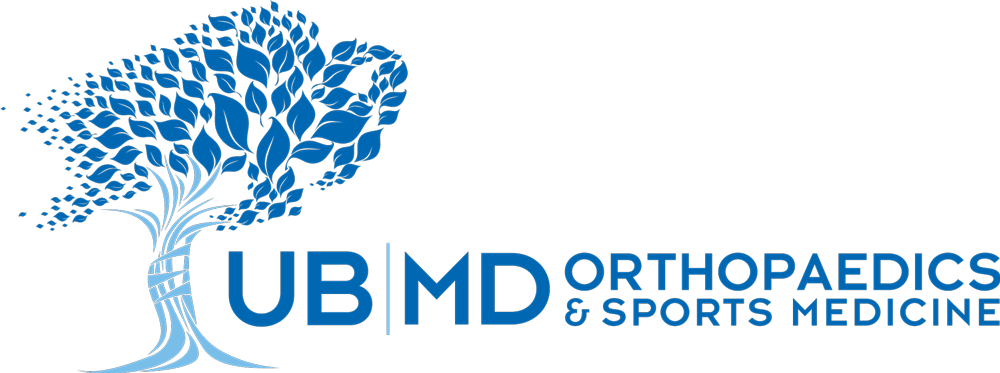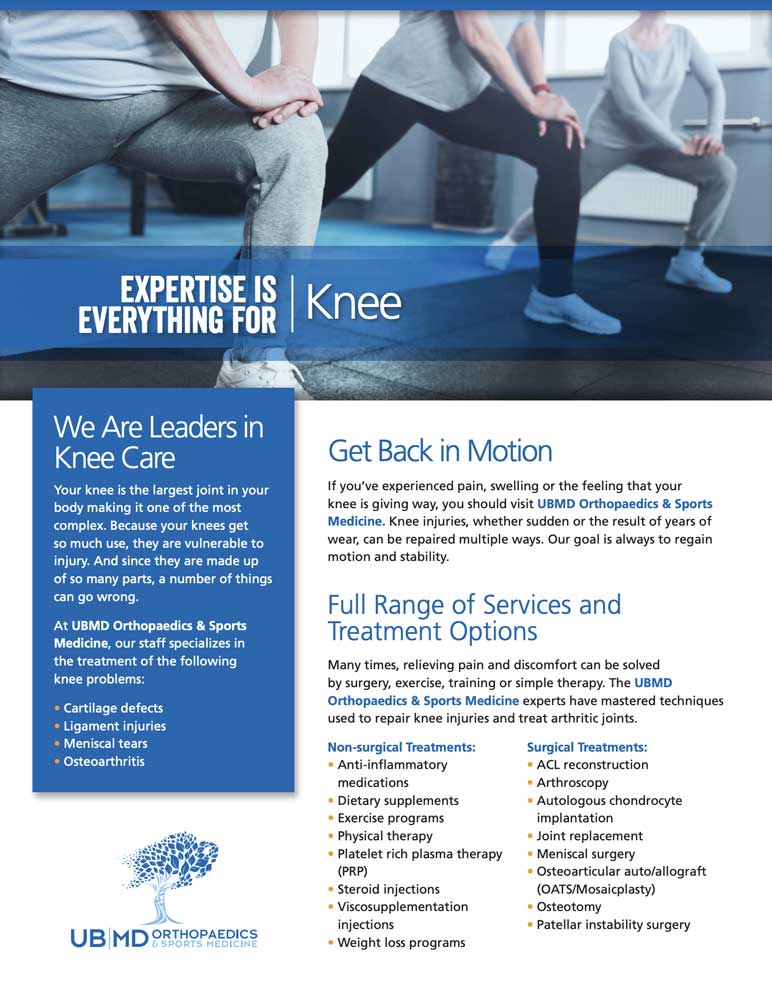
Knee
Knee pain is a very common problem in the general population. You or someone you know may suffer from knee pain or other knee-related conditions, potentially from an injury, a sports strain or arthritis. The knee is one of the most extensively used joints in the body and supports more weight than most other joints — factors that can also play a role in the prevalence of pain and problems with the knee. Whatever your concern, the team of physicians at UBMD Orthopaedics & Sports Medicine can help.
Among the most common knee problems are meniscus tears, ligament tears and arthritis. Each of these conditions is different, and may present differently in each individual. Our knee doctors are experienced with each of these issues, and can offer a comprehensive approach to assessing your condition and identifying the root cause of pain or lessened mobility. They offer a wide range of surgical and/or non-surgical treatment options — including robotic knee surgery and less invasive procedures — to remediate your issues, alleviate knee pain and restore your range of motion.
Our board-certified and board-eligible physicians include experts in regenerative medicine, sports medicine and joint replacement. From physical therapy to arthroscopy and joint replacement, we are here to help you get back on your feet.
Non-surgical Treatments:
- Anti-inflammatory
medications - Dietary supplements
- Exercise programs
- Physical therapy
- Platelet rich plasma therapy
(PRP) - Steroid injections
- Viscosupplementation
injections - Weight loss programs
Surgical Treatments:
- ACL reconstruction
- Arthroscopy
- Autologous chondrocyte
implantation - Joint replacement
- Meniscal surgery
- Osteoarticular auto/allograft
(OATS/Mosaicplasty) - Osteotomy
- Patellar instability surgery
Learn more about the full range of conditions and injuries that affect the knee on the American Academy of Orthopaedic Surgeons’ website, or schedule a consultation today with a knee expert at UBMD Orthopaedics & Sports Medicine.
Schedule an appointment now
Surgical
Mark J. Anders, MD
Geoffrey A. Bernas, MD
Leslie J. Bisson, MD
Clayton L. Del Prince, MD
Evgeny A. Dyskin, MD, PhD
Marc S. Fineberg, MD, FAAOS
Joseph B. Kuechle, MD, PhD
Brian E. McGrath, MD
Christopher E. Mutty, MD
Matthew J. Phillips, MD
Sridhar R. Rachala, MD
Michael A. Rauh, MD
Andrew P. Stegemann, DO
William M. Wind, Jr., MD
Pediatrics-Surgical
Allison S. Binkley, MD
Jeremy P. Doak, MD
Michael R. Ferrick, MD
Did you know?
Our sports medicine surgeons have proven that our innovative knee arthroscopy techniques result in faster recovery for patients in comparison to standard treatment. Learn more.
Did you know?
Our sports medicine surgeons recently published a study that focuses on patient outcomes after partial meniscectomy. Watch the video here.
Patient Testimonials
“I called for an appointment being in pain with my knee. They scheduled me an emergency appointment, and the doctor was so polite, very knowledgeable and explained everything to me. I walked out feeling relief from all the pain. I am very happy about the group. Staff were polite and courteous.”
“About four years ago, I had arthroscopic surgery on my right knee performed successfully by Dr. Geoffrey Bernas. Last month I had the same surgery on my left knee performed again by Dr. Bernas. Today my knees are as strong as I can ever remember. I can’t thank the team at UBMD enough! They performed flawlessly, professionally and gave me my active lifestyle back.”
“I will be forever grateful to Dr. Wind and his staff. Dr. Wind completely changed my quality of life, and I am now able to walk and run without pain!”
Frequently Asked Questions About Knee Pain
Blank
What are the most common causes of knee pain?
Knee pain can result from:
- Injuries – Sprains, strains, meniscus tears, ligament injuries (ACL, MCL, PCL, LCL).
- Overuse Conditions – Patellar tendinitis, runner’s knee, IT band syndrome.
- Arthritis – Osteoarthritis, rheumatoid arthritis, gout.
- Cartilage Damage – Meniscus tears or chondromalacia (softening of cartilage).
- Bursitis – Inflammation of the fluid-filled sacs cushioning the knee.
- Patellar Issues – Dislocation, tracking problems, or kneecap pain.
When should I see a doctor for knee pain?
Seek medical attention if you experience:
- Severe pain or swelling that doesn’t improve with rest.
- Inability to bear weight or walk without pain.
- Knee instability or a feeling of “giving out”.
- A popping sound followed by pain after an injury.
- Visible deformity or misalignment of the knee.
- Pain lasting more than a few weeks, even with home treatment.
If you experience any of these symptoms, it’s best to consult with an orthopedic specialist or a podiatrist to get a proper diagnosis and treatment plan. Early medical intervention can help prevent further damage and improve recovery outcomes.
How is knee pain diagnosed?
Doctors may use:
- Physical Examination – Checking range of motion, swelling, and stability.
- X-rays – To detect fractures, arthritis, or bone spurs.
- MRI or Ultrasound – To examine soft tissue injuries (ligaments, cartilage, tendons).
- CT Scan – For a more detailed view of bones and joints.
- Blood Tests – To check for conditions like gout or infections.
What are the best treatments for knee pain?
Treatment depends on the cause but may include:
- Rest & Ice – To reduce swelling and pain.
- Pain Relievers – NSAIDs like ibuprofen or acetaminophen.
- Physical Therapy – Strengthening and mobility exercises.
- Knee Braces or Supports – To stabilize and protect the knee.
- Corticosteroid Injections – For severe inflammation.
- Surgery – Arthroscopy, ligament repair, or knee replacement in severe cases.
Can knee pain be prevented?
Yes, by:
- Maintaining a healthy weight to reduce knee stress.
- Stretching and strengthening leg muscles.
- Wearing proper footwear for support.
- Avoiding excessive high-impact activities without proper training.
What are the best home remedies for knee pain?
- RICE Method (Rest, Ice, Compression, Elevation).
- Gentle stretching to improve mobility.
- Anti-inflammatory diet (turmeric, omega-3s).
- Foam rolling & massage to reduce stiffness.
What exercises help relieve knee pain?
- Straight leg raises – Strengthen thigh muscles.
- Wall sits – Build knee and quad strength.
- Heel & calf stretches – Improve flexibility.
- Clamshell exercises – Strengthen hip and knee stability.
Can knee pain be related to other health conditions?
Yes, conditions like arthritis, gout, lupus, and infections can contribute to knee pain.
Does weather affect knee pain?
Yes, some people experience more pain in cold or rainy weather, likely due to changes in barometric pressure affecting joint tissues.
When is surgery necessary for knee pain?
Surgery may be needed if:
- There is a complete ligament or meniscus tear.
- Arthritis severely limits movement and daily function.
- Pain persists despite 6+ months of treatment.

